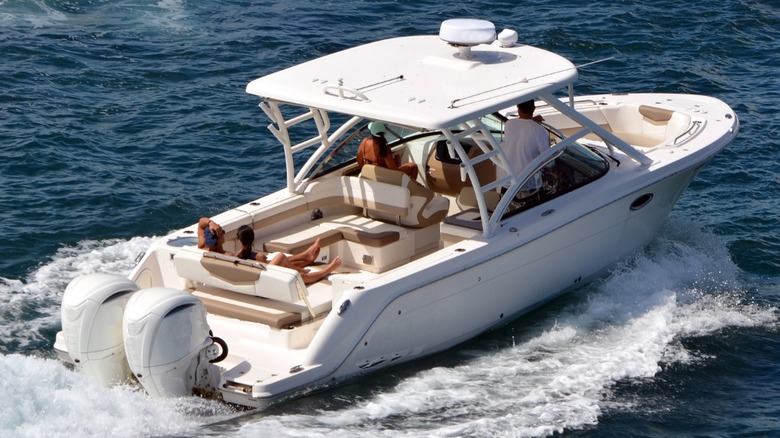
richard pross/Shutterstock
Boating is a popular recreational activity, and it could also be used as a form of transportation for moving between coastal and river areas. Since we often don’t see a boat’s method of propulsion and its engine, we wouldn’t usually think about how these watercraft move about on the surface.
Unlike cars, which have their engines placed at the front or rear of the cabin, boats have four basic types of engines. These four types have different placement methods and have their own advantages. The size of the boat and its intended use will affect the options you have, that’s why you’ll notice some boats usually come with a particular engine type.
So, let’s explore four types of boat engines, examine their differences, and discover how they work. Of course, there will be other rarer types out there, but we will only stick with the most common boat engines for today.
Outboard engine
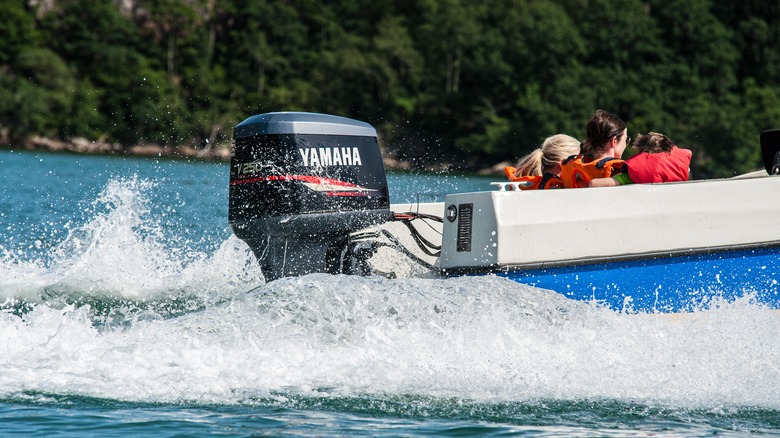
Trygve Finkelsen/Shutterstock
Outboard engines are highly suitable for smaller watercraft, which makes them one of the most used engines out there because of the prevalence of these small boats for pleasure and recreation. They’re also called outboard engines because they’re mounted outside the boat, usually on the transom, the beam that strengthens the stern structure of most boats. These engines typically come as a single complete power unit — from the engine and transmission to the shaft and propeller. Because of this, the smaller outboard engines are easier to work on, as you can remove the entire assembly if you need to service it or fix something. Nevertheless, you can also find outboard engines with large V8s, like the Honda BF350.
Another reason that the outboard engine is pretty popular is its ease of use. Boats with this engine type don’t need to have a rudder, as the entire engine assembly moves around to steer it. For smaller boats, you can do so by using a hand tiller, while some larger ones use a steering wheel that’s connected to the engine.
You can find outboard engines with varying fuel or energy sources. They’re usually powered by gasoline or diesel engines, but you can also find variants powered by a gasoline-and-oil mixture, as well as battery-powered motors primarily used for trolling and electric boats. Yamaha is one of the more popular makers of these engines, so you can check out these things if you want to know more about the Yamaha Marine Engine.
Inboard engine
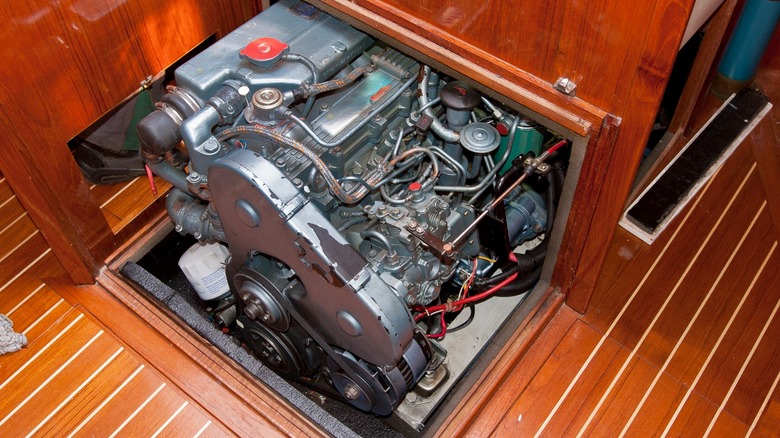
Umomos/Shutterstock
The inboard engine is what you would typically think of in ships and larger boats — it is composed of an engine placed near the middle of the boat for balance and trim, with a transmission connected directly to it. A shaft then goes from this system through the hull of the boat, with the propellers sitting at its very end. The propellers are near the stern of the boat to provide power, but since everything in the inboard engine is fixed in place, you would need a rudder to deflect the flow from the propellers and steer the watercraft.
You can often find this engine type on boats that are 26 feet or longer, especially as these are heavier and would need larger engines. Aside from that, inboard engines usually use modified four-stroke automotive engines, which can deliver more horsepower and torque when needed. One more advantage of the inboard engine is the predictability of the wake that it produces, making it a great option for water sport enthusiasts. Since the propeller is fixed under the boat, changing the directions (using the rudder) won’t have as great of an effect compared to outboard engines and stern drive boats.
Stern drive boats
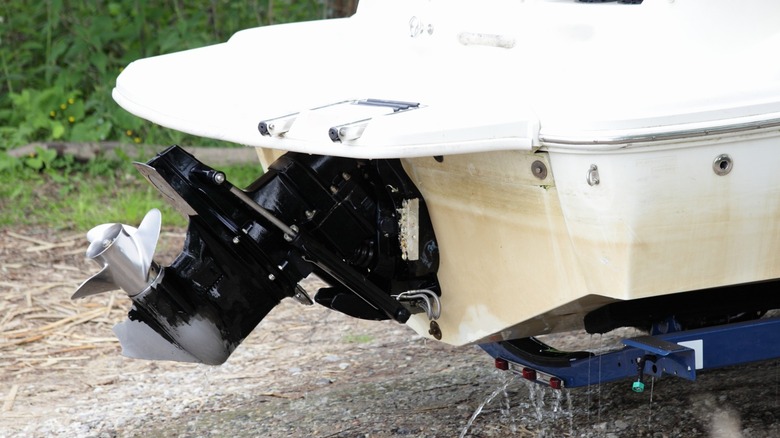
ilmarinfoto/Shutterstock
This engine type is divided into two parts — the engine is similar to the inboard engine in that it uses modified four-stroke automobile engines placed inside the boat. However, its drive unit is more like that of the outboard engine, with the complete propeller assembly turning for steering. Since stern drive boats use the same engine as inboard engines, they usually have higher horsepower and torque than you can find on the latter. Another advantage of the stern drive boat is that since its engine is fixed in place, you can easily service it in place inside the boat.
But, at the same time, it’s also more agile and maneuverable because of how the drive unit moves to steer the boat. This makes it useful for boats that typically move around in tight waterways. This makes the stern drive a common engine type for larger pleasure boats, which makes them easier to pilot. The stern drive boat offers the best of both inboard and outboard engines. It can use larger, more powerful engines than outboard motors, and with the engine placed at the stern, you’ll have more open space near the center of the boat. You can also adjust the pitch of the drive unit to help trim the boat while you’re underway.
Jet drive boats
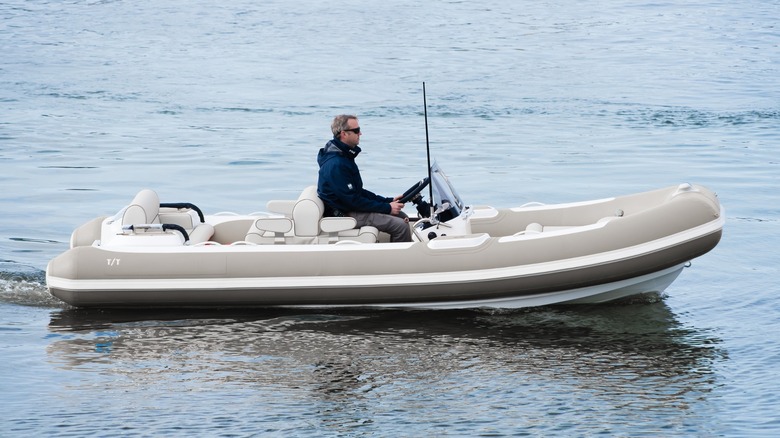
Lucia.Pinto/Shutterstock
Just as its name suggests, a jet drive boat is similar to a jet engine in that its propeller is inside a pod or container. Instead of having a propeller outside the boat, which is a potential danger to people and wildlife in the water, a jet drive boat has its engine inside the hull which then powers an impeller that sucks water through an intake nozzle. It then discharges the high pressure from the back of the boat through one or more nozzles that propel the boat at high speed.
The nozzle swivels around to steer the boat, thus removing the need for a rudder. However, when the boat or personal watercraft isn’t being propelled forward at high speed, you’d have less steering control of the boat, making it difficult to navigate in tight spaces. Furthermore, if the intake gets choked by seaweed or other contaminants, it might be a bit difficult to clear. Jet drive is often used by personal watercraft, like jet skis. However, it can also be used by larger boats that are designed to work in shallow water. Furthermore, you can also get outboard motors that use jet drive to propel your watercraft.
Which boat engine should you get?
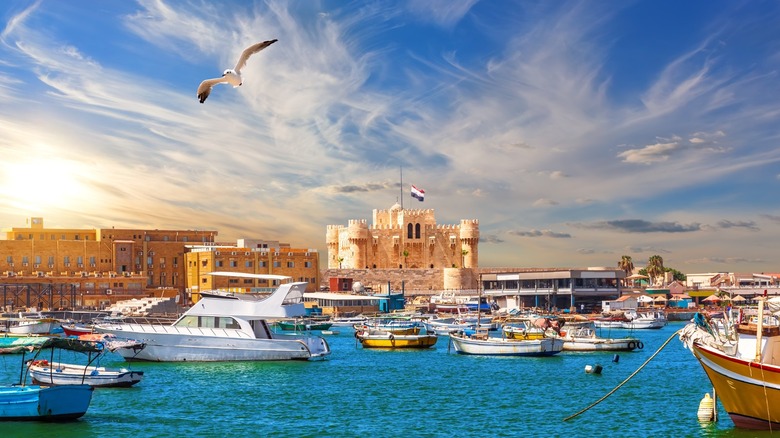
AlexAnton/Shutterstock
While you might be tempted to get a jet drive engine with the highest possible output rating to get the best speed that you can, you shouldn’t do that. Instead, the biggest thing that you should consider is the size of your boat. All hull types have a speed rating, so you shouldn’t get an engine that’s way too powerful for the hull that you have.
But you shouldn’t get the smallest possible engine as well, as an underpowered motor will make it harder for you to get underway. This will mean that the engine will have to work harder to move your boat, thus it will burn more fuel. So, you should get the recommended engine power and type that your hull manufacturer suggests.
Aside from that, you should also consider the number of people and cargo you typically carry. If you usually bring all your friends and family on your large yacht, then consider going for the higher horsepower rating for your boat. But if you prefer boating alone or with just your partner, then the engine with the lower rating should be more than enough.